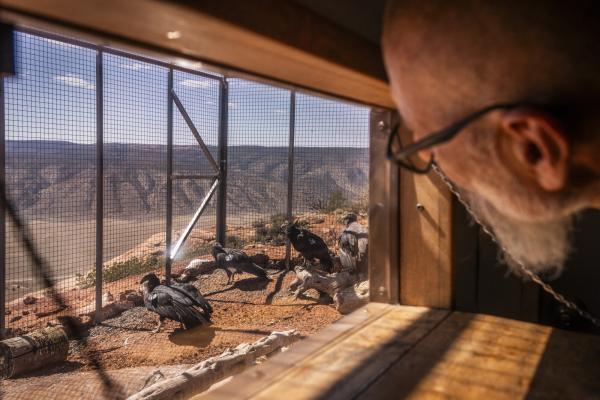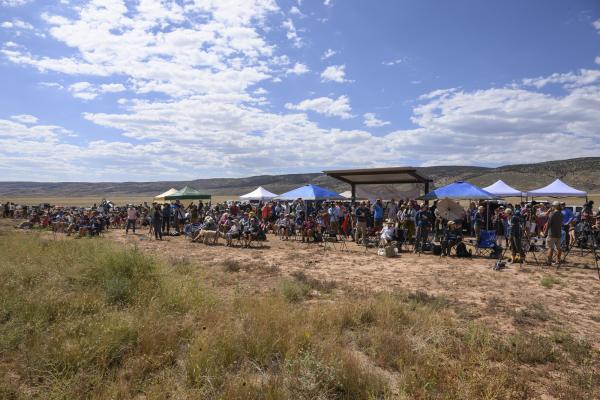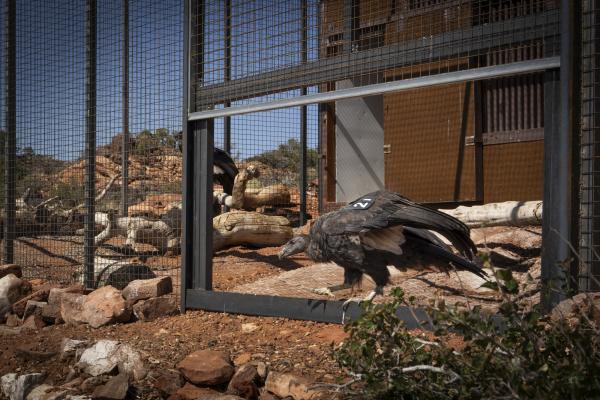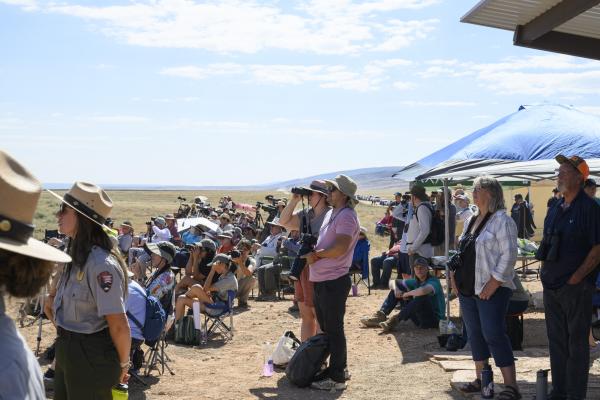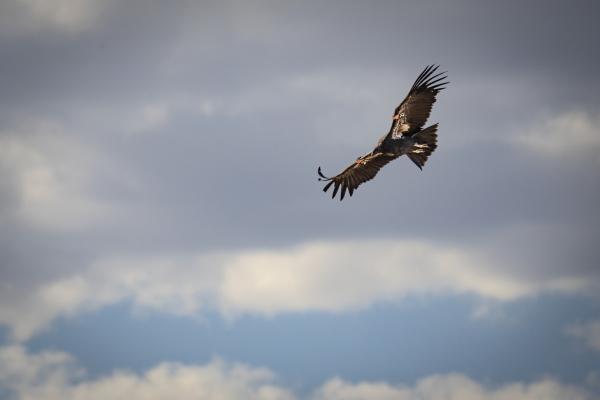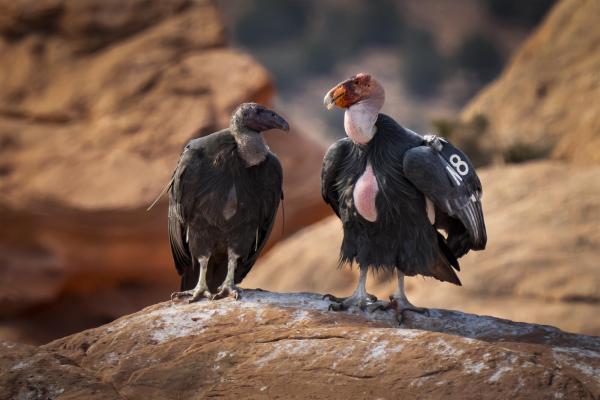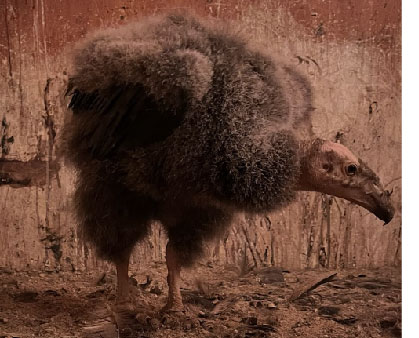Support Our Ongoing Work to Protect the California Condor!
Previous Updates
September 28, 2024: Four California Condors entered the wild for the first time at the 28th annual California Condor Release! Over 600 people joined in-person at Vermilion Cliffs National Monument to celebrate, while the livestream received well over 3,000 views during broadcast! Watch a recording of the release here.
May 28, 2024: A new challenge we are facing is the availability of safe, reliable, and affordable food sources for captive condors. The normal food supply has been impacted by the ongoing outbreaks of HPAI in dairy cattle. As a result, feed prices have increased for The Peregrine Fund this year and we need your help to cover an unanticipated, additional cost of $50,000 to get these condors through September 2024.
May 1, 2024: We’re relieved to report that the story of the California Condors and their fight against Highly Pathogenic Avian Influenza (HPAI) has taken a hopeful turn with the epidemic passing for now. Unfortunately, the threat of lead poisoning from ammunition continues to severely impact condors, with poisoning events causing sickness and even death. The Peregrine Fund confirms that nearly half of all condor deaths are due to this one preventable cause. There are solutions, though. Through education, non-lead alternatives, and a steadfast commitment to hands-on management, monitoring, and treatment, this majestic species has a chance. Your support is the energy that fuels our work.
October 16, 2023: We bet you are wondering how Condor 1221 is doing, aren’t you? Here is the latest from Leah Esquivel, Propagation Manager:
As of 10/16, 1221 has officially fledged! It's been fun watching her explore the pen and practice short flights. Now that she can reach the food she's been great at feeding herself, although whenever she sees an opportunity, she does continue to beg and be fed by her foster parents. Now we are monitoring her progress with flying and eating to make sure she is ready before moving her to the socialization pen, where she'll spend the next year before heading out to the release site.”
The fall issue of Audubon magazine featured an in-depth cover story on the initial journey of female nestling 1221, whose story we first brought to you in these email updates.
We extend our sincere gratitude to those of you who have contributed to the California Condor Program during this year of tragedy, resilience, innovation, and hope. Financial support is still needed for field and propagation efforts and for ongoing analysis by our science team. We are so grateful for our challenge donors, who are doubling your donations right now. A heartfelt thanks to the Jeremy and Amy Hanks Foundation, Jennifer Speers, and Tim and Kate Coiner.
August 24, 2023: Earlier this summer, we introduced you to our miracle nestling, 1221, whose egg was recovered from a cave where her father was incubating. Because the cave was the perfect breeding ground for the deadly strain of Highly Pathogenic Avian Influenza (HPAI) and for the health of the father, our team at Condor Cliffs recovered the egg and took it to Liberty Wildlife where it hatched. The female nestling was then flown to The Peregrine Fund’s breeding facility in Boise and placed with two very caring foster parents. This young condor is now thriving!
“1221 is doing great and growing big! She's a voracious, feisty bird that will make a great wild bird in the future. She spends a lot of time preening her growing feathers and practicing her wing flaps. Right now she's concentrating on growing, sleeping, and eating so she can be ready for that next big step of fledging the nest.”—Leah Esquivel, Propagation Manager, The Peregrine Fund
Leah and her team will continue to watch the miracle nestling closely to make sure she's hitting her continuing developmental milestones and we are hopeful that she will be released back to her home at Marble Canyon close to this time next year.
U.S. Fish and Wildlife Service’s Incident Command Team, in collaboration with partner agencies, continues to develop and implement conservation strategies to help California Condors in light of HPAI. Strategies include the implementation of vaccine trials. The Peregrine Fund supports those strategies through continued field monitoring and adaptation of current management practices to improve response to future HPAI outbreaks.
Many of YOU have played a vital role in this recovery effort. Thank you for your past and continued support to protect our wild population of condors in Arizona and Utah, and in Boise to get this young bird to where she is today. Financial support is still needed for field and propagation efforts, and for analysis by our science team. We are grateful for our challenge donors, who are doubling your donations right now. Sincere thanks to Jeremy and Amy Hanks Foundation, Jennifer Speers, and Tim and Kate Coiner.
July 28, 2023: We are happy to report that no new cases of HPAI have been detected in our Arizona-Utah population since April 11. Through your generous support, intensive monitoring of our wild population continues and The Peregrine Fund’s science team is hard at work analyzing data to improve our management practices for future, catastrophic disease outbreaks.
Our datasets on the movement, survival, captive releases, and wild reproduction of California Condors were collected by our intrepid field crew and managed by our Database Architect, Leah Dunn. Our Spatial Ecologist, Dr. Jennifer McCabe, is analyzing these datasets to determine which condors are showing behavioral signs of Highly Pathogenic Avian Influenza (HPAI) or have been in contact with infected individuals. This movement work will allow us to alert biologists to condors showing behavioral symptoms of HPAI, and identify other condors that have been in contact with potentially infected individuals. We hope to predict which condors are infected based on data from their GPS tags. This will allow us to act quickly to treat infected individuals and prevent them from spreading the disease in the future.
Our Quantitative Ecologist, Dr. Brian Rolek, is analyzing the survival and reproductive rates of the Arizona-Utah population to predict how many releases will now be needed to replace the victims of HPAI. We will use these values in a simulation model to estimate the time it will take the population to recover and help us plan the number of birds we will need to release in the coming years.
Our analysis is based on VHF telemetry and GPS data. Since the HPAI outbreak in late March, five of our GPS units have ceased operations and need replacing. Your contributions will help our science team understand and share vital information for condor recovery, keep our team on the ground monitoring condors, and help purchase GPS units needed in the field.
Contributions are being matched dollar for dollar right now. We are incredibly grateful to our challenge donors: Jeremy and Amy Hanks Foundation, Jennifer Speers, and Tim and Kate Coiner.
Here's how you can help.
Right now, our most urgent need is financial support for:
- Propagation of condors in Idaho where we breed young condors for release into the wild.
- Monitoring and management of threats to wild condors in Arizona and Utah so they can thrive in their desert habitat.
- Analysis by our international science team to determine how many young condors must be released to recover from this deadly influenza outbreak.
- Development of new tools to monitor condors for early detection of infection so that treatment can be most effective.
Along with your financial support, you can send words of encouragement to our field crew on the ground in Utah and Arizona.
Match your gift: Three donors came forward with a $95,000 matching challenge. We want to thank Jeremy and Amy Hanks Foundation, Jennifer Speers, and Tim and Kate Coiner for their amazing generosity. We hope their challenge inspires more people to play a role in this recovery effort.
June 9, 2023: On April 17th, our field team recovered an egg from the nest of a mother who died from HPAI. With a small cooler equipped with heat warmers and towels, The Peregrine Fund team climbed down to the cave, secured the egg, hiked out, and immediately delivered the egg for incubation to Liberty Wildlife, a rehabilitation partner in Phoenix.
On May 9th, the egg hatched and within days tested negative for Highly Pathogenic Avian Influenza (HPAI) - a HUGE sigh of relief. At just over a week old, she was flown to The Peregrine Fund’s captive breeding facility in Boise, Idaho for fostering. As of June 8th, our Propagation Manager, Leah Esquivel is happy to report that the hatchling is doing fantastic! “She's eating well from her foster parents and acting like a normal young condor.” Leah and her team will continue to watch the hatchling closely to make sure she's hitting developmental milestones.
Thanks to our partners the Idaho Department of Fish and Game and the Idaho Department of Agriculture along with U.S. Fish and Wildlife Service, Liberty Wildlife, and our friend and pilot Don Reiman who flew the hatchling safely to Boise. With their support and YOURS, our miracle nestling is thriving and we are doing everything we can to prepare her for return into the wild.
May 16, 2023: We are happy to report more good news as spring takes hold in Arizona and Idaho. Our field teams have not detected any additional compromised California Condors in northern Arizona since April 11, and four birds in veterinary care continue to show signs of recovery. The Peregrine Fund’s captive breeding program is also in full swing, and new life is hatching. Of 18 eggs laid, nine young have hatched and a new season for the recovery effort begins.
To date, all confirmed cases of Highly Pathogenic Avian Influenza in California Condors were found in northern Arizona. Thankfully, Avian Influenza has not been detected in any of the other populations: California, Baja California, and Mexico.
Late last month an incident command team was convened to enhance supportive care facilities for sick birds, maintain sufficient support for field operations and monitoring, coordinate with USDA regarding the potential vaccination of condors, and develop long-term strategies for the future. Together with our partners, we are caring for recovering birds, evaluating care and quarantine facilities, and continuing to refine safety procedures for field crews.
Even in this moment of relief, The Peregrine Fund field team continues intensive, daily monitoring and management of the flock in Arizona and Utah. Our California Condor recovery leadership team is working with partners to modify facilities and define best practices for safety procedures, working especially closely with Dr. Sam Gibbs, National Avian Health and Disease Program Coordinator for U.S. Fish and Wildlife Service.
April 19, 2023: A glimmer of hope arrived in Marble Canyon, Arizona over the past several days as emergency rescue teams took a breath and Vermilion Cliffs National Monument temperatures rose to 90 degrees. The unusually wet and cold winter conditions this year may have played a role in the occurrence and spread of Highly Pathogenic Avian Influenza (HPAI). While our crews are ready to recover and address the needs of more sick birds at any time, new signs of infection in our flock have decreased and some of the birds in supportive care are showing signs of improvement.
As of April 17, 2023, 20 condors have died in the Arizona-Utah flock, and HPAI has been confirmed for 10 of those condors. Eight additional birds have been brought in for supportive care. Four of those condors died shortly after and are included in the total of 20 diseased birds. Four condors are still receiving supportive care and are seeing improvement.
The fight is far from over. Losses include 14 breeding-aged birds, 11 of which had recently been observed to be nesting or tending to young. In a matter of weeks, this event has set our recovery effort back a decade or more. Our science team is already analyzing emergency data to help define this long road to recovery. Before the outbreak of HPAI, the leading cause of death (accounting for 50% of confirmed mortalities) was lead poisoning. This new threat of HPAI, for which we do not yet have a solution (like a vaccine), highlights the need to address preventable and manageable threats, and rely even more heavily on proven strategies such as captive breeding to increase the wild population.
April 13, 2023: Recovery efforts continue on the ground as we await laboratory results to confirm additional suspected cases of Highly Pathogenic Avian Influenza (HPAI) in our Arizona-Utah flock. Additional birds have been rescued by our field crews in an effort to provide supportive care at Liberty Wildlife and give them a fighting chance at making it through this devastating virus. This population, managed by The Peregrine Fund, is the first known condor population to be impacted by HPAI. Thankfully, the populations in California are not currently experiencing this pandemic.
Prior to this outbreak, the population in Arizona and Utah was 116 individual birds.
Crews continue to work around the clock, and support staff have arrived to provide some relief for the core team. In addition to rappels off 1,000-foot cliffs, our teams recently rescued two sick condors in Grand Canyon National Park by boat, with support from the National Park Service, and Peregrine Fund biologists are hiking through the formidable canyonlands to recover additional birds.
